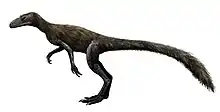| Scleromochlus Temporal range: Late Triassic, | |
|---|---|
 | |
| Cast of holotype specimen NHMUK R3556 | |
| Scientific classification | |
| Domain: | Eukaryota |
| Kingdom: | Animalia |
| Phylum: | Chordata |
| Clade: | Ornithodira |
| Clade: | †Pterosauromorpha |
| Family: | †Scleromochlidae Huene, 1914 |
| Genus: | †Scleromochlus Woodward, 1907 |
| Species: | †S. taylori |
| Binomial name | |
| †Scleromochlus taylori Woodward, 1907 | |
Scleromochlus (from Greek: σκληρός sklērós, 'hard' and Greek: μοχλός mokhlós, 'lever') is an extinct genus of small pterosauromorph archosaurs from the Late Triassic period. The genus contains the type and only species Scleromochlus taylori, named by Arthur Smith Woodward in 1907.[1]
Discovery

Its fossils have been found in the Carnian Lossiemouth Sandstone of Scotland. The holotype was discovered around 1900 and is listed as specimen BMNH R3556, a partial skeleton preserved as an impression in sandstone, with portions of the skull and tail missing.[1]
Description
Scleromochlus taylori was about 181 millimetres (7.1 in) long, with long hind legs; it may have been capable of four-legged and two-legged locomotion. Studies about its gait suggest that it engaged in kangaroo- or springhare-like plantigrade hopping;[2][3][4] however, a 2020 reassessment of Scleromochlus by Bennett suggested that it was a "sprawling quadrupedal hopper analogous to frogs."[5] If Scleromochlus is indeed related to pterosaurs, this may offer insight as to how the latter evolved, since early pterosaurs also show adaptations for saltatorial locomotion.[6]
Classification



A lightly built cursorial animal, its phylogenetic position has been debated; as different analyses have found it to be either the basal-most ornithodiran, the sister-taxon to Pterosauria, or a basal member of Avemetatarsalia that lies outside of Ornithodira. In the phylogenetic analyses conducted by Nesbitt et al. (2017) Scleromochlus was recovered either as a basal member of Dinosauromorpha or as a non-aphanosaurian, non-pterosaur basal avemetatarsalian. However, the authors stressed that scoring Scleromochlus was challenging given the small size and poor preservation of the fossils, and stated that it could not be scored for many of the important characters that optimize near the base of Avemetatarsalia.[7]
In 2020, Bennett interpreted Scleromochlus as possessing certain characteristics, including osteoderms and a crurotarsal morphology of the ankle, which suggested that Scleromochlus was not closely related to ornithodirans. Instead, he argued for a position of Scleromochlus among the Doswelliidae or elsewhere among basal members of the Archosauriformes.[5]
However, in 2022, Foffa and colleagues reconstructed a complete skeleton using microcomputed tomographic scans of the seven specimens found to date. This enabled a new phylogenetic analysis to be undertaken, which strongly supported the hypothesis that Scleromochlus was a member of the Pterosauromorpha – either as a genus of the Lagerpetidae family (shown to be a part of Pterosauromorpha in 2020[8]) or as the sister group to pterosaurs and lagerpetids. Previous alternative classifications were demonstrated to have been based on misinterpretations of incomplete or ambiguous anatomical features found in the fossil record.[9][10]
References
- 1 2 Woodward, A.S. (1907). "On a New Dinosaurian Reptile (Scleromochlus Taylori, gen. Et sp. Nov.) from the Trias of Lossiemouth, Elgin". Quarterly Journal of the Geological Society. 63 (1–4): 140–144. doi:10.1144/GSL.JGS.1907.063.01-04.12. S2CID 131522263.
- ↑ Sereno, Paul C.; Arcucci, Andrea B. (1994). "Dinosaurian precursors from the Middle Triassic of Argentina: Marasuchus lilloensis, gen. nov". Journal of Vertebrate Paleontology. 14 (1): 53–73. doi:10.1080/02724634.1994.10011538. ISSN 0272-4634.
- ↑ Benton, Michael J. (1999). "Scleromochlus taylori and the origin of dinosaurs and pterosaurs". Philosophical Transactions of the Royal Society B: Biological Sciences. 354 (1388): 1423–1446. doi:10.1098/rstb.1999.0489. JSTOR 57034. PMC 1692658.
- ↑ Witton, Mark P. (2013). Pterosaurs: Natural History, Evolution, Anatomy. Princeton University Press. ISBN 9780691150611.
- 1 2 Bennett, S. Christopher (2020). "Reassessment of the Triassic archosauriform Scleromochlus taylori: neither runner nor biped, but hopper". PeerJ. 8: e8418. doi:10.7717/peerj.8418. ISSN 2167-8359. PMC 7035874. PMID 32117608.
- ↑ Witton, Mark P. (2015). "Were early pterosaurs inept terrestrial locomotors?". PeerJ. 3: e1018. doi:10.7717/peerj.1018. ISSN 2167-8359. PMC 4476129. PMID 26157605.
- ↑ Nesbitt, S.J.; Butler, R.J.; Ezcurra, M.D.; Barrett, P.M.; Stocker, M.R.; Angielczyk, K.D.; Smith, R.M.H.; Sidor, C.A.; Niedźwiedzki, G.; Sennikov, A.G.; Charig, A.J. (2017). "The earliest bird-line archosaurs and the assembly of the dinosaur body plan". Nature. 544 (7651): 484–487. Bibcode:2017Natur.544..484N. doi:10.1038/nature22037. PMID 28405026.
- ↑ Ezcurra, Martín D; Nesbitt, Sterling J.; Bronzati, Mario; Dalla Vecchia, Fabio Marco; Agnolin, Federico L.; Benson, Roger B. J.; Brissón Egli, Federico; Cabreira, Sergio F.; Evers, Serjoscha W.; Gentil, Adriel R.; Irmis, Randall B.; Martinelli, Agustín G.; Novas, Fernando E.; Roberto da Silva, Lúcio; Smith, Nathan D.; Stocker, Michelle R.; Turner, Alan H.; Langer, Max C. (2020). "Enigmatic dinosaur precursors bridge the gap to the origin of Pterosauria". Nature. 588 (7838): 445–449. doi:10.1038/s41586-020-3011-4. ISSN 1476-4687. Retrieved 6 October 2022.
- ↑ Foffa, Davide; Dunne, Emma M.; Nesbitt, Sterling J.; Butler, Richard J.; Fraser, Nicholas C.; Brusatte, Stephen L.; Farnsworth, Alexander; Lunt, Daniel J.; Valdes, Paul J.; Walsh, Stig; Barrett, Paul M. (2022). "Scleromochlus and the early evolution of Pterosauromorpha". Nature. 610 (7931): 313–318. doi:10.1038/s41586-022-05284-x. hdl:20.500.11820/3134b3f1-41e0-47bb-9688-a5e5b0b64492.
- ↑ Gill, Victoria (6 October 2022). "Scottish fossil revealed to be pterodactyl ancestor". BBC News. BBC. Retrieved 6 October 2022.





